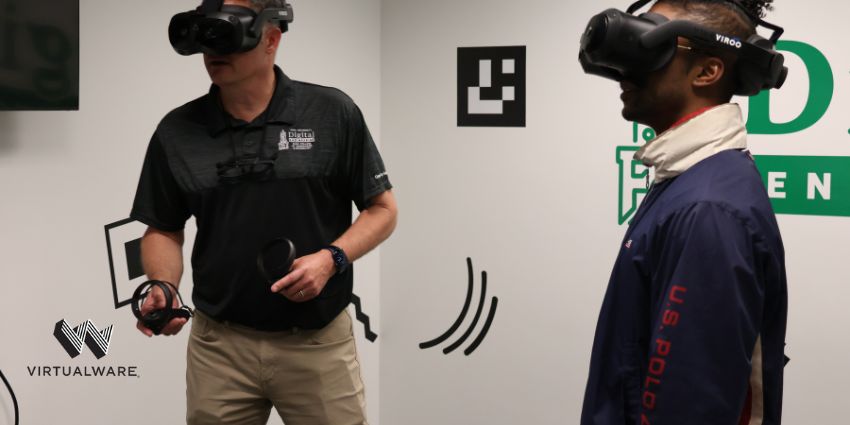While virtual reality first found fame as an entertainment tool in the consumer space, the impact it had on the enterprise over the last 12 months proves its value goes way beyond video gaming alone.
According to a recent Grand View Research report, the virtual reality market, valued at USD 10.32 billion in 2019, is expected to grow at a CAGR of 21.6% from 2020 to 2027, with a significant growth portion coming from enterprise investments.
Throughout 2020, we saw VR used predominantly as a way to enhance corporate training and allow healthcare organizations to cope with the massive strains placed on them during the COVID-19 pandemic – but that was just the beginning!
In fact, many leading figures within the VR space agree that VR/XR collaboration will become the new standard in working life by 2025, which is why investing in this technology now is an excellent strategy for any business leader.
However, as tempting as it may be to catch the trend early and get ahead of the competition today, investing in the wrong VR collaboration platform now could prove disastrous for businesses further down the line.
Considering this, we created a list of crucial questions every business leader must ask themselves before investing in a VR collaboration platform in 2021.
Let’s take a look below to find out more.
What kind of avatars does it use?
If making a good first impression is the key to success, it’s crucially important that businesses avoid using avatars that are poor in quality or designed in a way that’s considered too “cartoonish.”
Since VR collaboration started its life in the video gaming space, many of the technologies available on the marketplace today still haven’t adapted to meet enterprise users’ requirements.
While it’s still too early to expect super high-resolution renderings of faces at scale within virtual reality environments, businesses should avoid using childish avatars at all costs.
Instead, choosing a VR collaboration platform that offers more conservative designs is a great way to maintain professionalism and build a better reputation in the virtual workplace.
Will the features help you reach your goals?
Before making any investment in VR, it is crucial that business leaders first determine what they hope to achieve with the platform before making the purchase.
For instance, a company that plans to use VR to collaborate on complex industrial, architectural, or automotive designs would need to use a platform rich in features capable of transferring large data files in real-time, often from one side of the world to the other.
However, a company that plans to use VR to collaborate in small weekly meetings or host presentations to clients is unlikely to need anywhere near as much power and complex features as the group mentioned above.
Considering the above, the business must set clear goals from the beginning to ensure they invest in the right type of VR collaboration platform capable of meeting their unique requirements.
Does it Integrate well with your existing investments?
As well as reviewing what features the VR collaboration platform offers, it’s essential to research how well the software integrates with other technologies already used within the organization.
For example, leading VR collaboration platform developers, MeetinVR, recently implemented OneDrive support into its offering and is already working on bringing other cloud drive solutions into the fold later this year.
Choosing a VR platform that integrates with essential collaboration tools used in the workplace is a great way to speed up production rates and ensure the business can capitalize on its VR collaboration platform investment from day one.
How many users does it support?
Alongside integrations with existing infrastructure, business leaders thinking of investing in VR collaboration must also consider the number of users they’ll want to include in each meeting before making their purchase.
When doing this, it’s essential to consider both the business’s present and future needs. For example, will the platform continue to support the organization as it grows? How easily can an organization increase or decrease the number of users? And what is the cost of doing this?
What sort of businesses already use it?
If still in doubt, it’s always useful for organizations to read through past or existing customers’ experiences to determine if the VR collaboration platform in question is right for their business.
In these reviews, it’s easy to determine what types of businesses have already invested in the platform and how successfully the tool has helped them overcome the problems they face.
VR Collaboration is the Future
Much like video collaboration and the smartphone did before it, we do not doubt that virtual reality collaboration technology will completely transform the way businesses communicate over the next five to ten years.
Cutting costs, driving up productivity, and allowing teams to communicate more naturally within digital work environments are some of the biggest advantages of investing in VR collaboration – but it doesn’t end there.
Perhaps the most significant value VR collaboration offers to the enterprise is that it enables businesses to build remote work strategies for the long-term, not just the short.
Considering this, investing in a VR collaboration platform now is a wise decision for any business leader– and answering these five simple questions beforehand is a great way to ensure the best possible return on that investment.







